|
FAQs about Live Rock Hitchhiker/Creature
Identification
22
Related Articles: Live
Rock, Reef Systems, Refugiums,
Related FAQs: Live Rock, Answering
Some LR FAQs by James Fatherree, LR
Hitchhiker ID 1, LR Hitchhiker ID
2, LR Hitchhiker ID 3, LR Hitchhiker ID 4, LR Hitchhiker ID
5, LR ID
6, LR ID 7, LR ID 8, LR ID 9,
LR ID 10, LR
ID 11, LR ID 12, LR ID 13, LR ID
14, LR ID 15, LR ID 16, LR ID17,
LRID 18, LRID
19, LRID 20, LRID 21, LRID
23, LRID
24, LRID 25, LRID 27, LRID 28,
LRID 29,
LRID 30, LRID 31,
LRID 32, LRID 33,
LRID 34, LRID 35,
LRID 36, LRID 37,
LRID 38,
&
Non-Vert IDs 1, Tubeworm ID, Polychaete Identification, Live Rock 1, LR 2,
LR 3, LR 4,
LR 5, Curing
Live Rock, Live Rock Selection,
Shipping/Moving, Placement, Lighting, Water Quality, Live Rock Studies in Fiji Collaboration
& Charts, Copper Use, Marine
Landscaping, Marine Biotope,
Sumps, Refugiums, Faux
Rock,
|
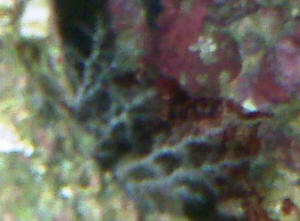
|
|
Live rock hitchhikers help 2/23/2010
Hello there.
<Hello Angela>
Let me start my saying you have a wonderful site.
<Thank you for your kind words!>
I think I am on here everyday (for the past few months).
<I know the feeling>
I have found many answers to many questions but still have a few
that I need answers to. Hope you can help.
<I'll give it a whirl!>
I have LR that has been quarantined for over 4 weeks with several
hitchhikers, many of which I have found to be good. Some of them
I am not so sure about. Hopefully you can help me identify
them.
<Ok, lets have a go then>
The first picture is of the "thing" closed, the second
is of it opened.
<This does look a little like a Zoanthid, but I think this is
a pest Anemone>
It is about 1/10 of an inch when it is open (barely visible).
<Really? And you spotted it? Well done>
The third and fourth picture is some kind of centipede or worm
(it has several legs with longer "arm" looking things
in the front). I think I have three of them, the longest is maybe
half an inch long and less than 1 mm in width (it slithers like a
snake and can move both ways like a worm). Do you have any idea
what they are and how to get rid of them if need be?
<This looks & sounds like a Bristleworm to me. Most likely
harmless, even beneficial, but if you want a better I.D. try this
great site:
http://www.chucksaddiction.com/hitchworms.html . It looks like
you could have a Vermetid Snail in the foreground of this picture
as well (the tube like thing)>
Sorry they are not the best pictures, I am still learning with my
new lens.
<No problem Angela, I think these are ok>
Thank you,
<Cheers!>
Angela
<Simon>
|
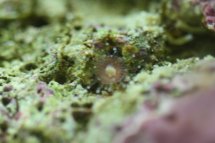 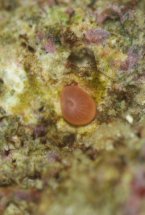 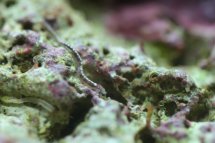 |
|
Unknown 'Critters'? 2/13/10
Hi Crew, Hi LynnZ.
<Hello Claire! What can I help you with today?>
I am sorry to bother you,
<No worries, I love these critter queries.>
..but perhaps you can help me to figure what these unknown
"things" are:
<I'll sure try.>
1) I remarked that my Goniopora does not fully open two days ago,
and then today I saw two protuberances at the basis of the
rock.
<Hmmm, I can't quite tell what they are (perhaps
Syconoid/other sponges or even some sort of bubble algae) but
judging by the algae, etc., covering them, it looks like
they've been there awhile. Perhaps they've just now
become visible because the Goniopora's polyps aren't
fully extended in that area? Goniopora can be a challenge to keep
alive. I would guess that whatever these two objects are,
they're unrelated to whatever's going on with the coral
itself. I would look to other factors. Please see the following
links for more information:
http://www.wetwebmedia.com/poritidhlthfaqs.htm
http://www.fishdomain.com/article_goniopora1.shtml >
2) On the rock of the Cladiella, I saw something too (sorry for
the blur, I did not succeed to get a better shot); and by the
way, it seems that with your help, I got rid of the two
Nudibranchs.
<Yay, at least those two are gone! Unfortunately, I can't
quite tell what I'm seeing in the photo. At first glance, it
appears to be a possible cluster of up to three sea slugs,
flatworms, or Nudibranchs. Unless I'm missing some details in
the photo, whatever it is doesn't look like the same
Tritoniopsis spp. as before, which is good. What does concern me
is the close proximity to the coral. That and the fact that
generally when you see Nudi's clustered together, they're
either feeding or reproducing/laying eggs. I've got a couple
of questions for you so that we can hopefully narrow things down.
Most importantly, are the subjects even mobile? Although at first
glance they appear to be some sort of slug, etc., I could be way
off. Can you give me a general size estimate? Are they
soft-bodied? If the subjects have moved away from the spot where
they were clustered, take a close look at the area and tell me if
you see any egg ribbons/strands. Finally, can you give me any
other details/observations such as appendages, texture, etc.? If
you happen to see these things again, and they look like any sort
of slug, I'd remove them. If/when you do, place one/several
in a shallow container with water, and see if you can get a
couple of good photos. It's much easier taking them in a
shallow bowl than it is in an aquarium! Here's a link showing
egg strands from Tritoniopsis elegans Nudibranchs, just in case.
We definitely need to rule out that possibility!
http://www.seaslugforum.net/showall/triteleg >
Thank you for your help, and have you and your crew, a wonderful
week-end.
<You're very welcome, and the same to you!>
Claire
<Take care, LynnZ>
|
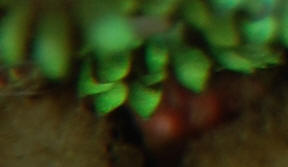 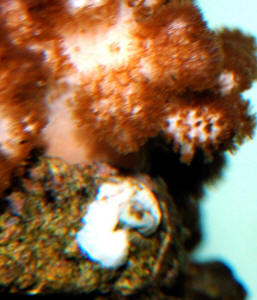 |
|
Unidentified White Animal? Possible Sponge or
Tunicate; Cleaner Shrimp Larvae - 2/7/10
Good evening from Suffolk, UK.
<Hello Nicki, Lynn here today from rainy Washington
state.>
This is the first time I have written to you after using your
website and many of your FAQs to help build our Marine aquarium
(set up December 2009), thank you for all the great advice and
fascinating reading.
<On behalf of Bob and the crew, you're very welcome and
thank you!>
To give you an idea of our set up we have; 400 litre tank with 20
kilos of living rock
Sump tank containing 40 kilos of living rock and 50 litres of
water
TMC V2skim 600
TMC Vectron 400 UV steriliser
2 Eheim compact pumps (for flow)
6 Reef white aqua-beam 500's
2 Reef blue aqua-beam 500's
Last test levels (this week) are Salinity 1.02
<I'd bring this up a bit, closer to 1.024-1.025. A
specific gravity of 1.020 is fine, long term, for fish-only
systems, but a reef system complete with invertebrates needs a
higher range. Just be sure to increase the specific gravity very
slowly, no more than .001/day. For more information, start here:
http://www.wetwebmedia.com/spg_salinity.htm >
pH 8.2, Nitrates 0, Nitrites 0 Ammonia 0.
2 true A. percula clowns
1 Sail-fin Yellow tang
1 Coral Beauty
1 Regal Tang
2 Cleaner Shrimp
4 Turbo Snails
1 Blue legged Hermit Crab
1 Halloween Hermit crab
1 Mushroom/leather Coral
1 Xenia Coral
Various unidentified (hitchhiking) Crabs, feather dusters,
sea
squirts, coral polyps.
I have two questions I am hoping you might be able to help me
with? Firstly I am writing to ask if you can identify yet another
new inhabitant which has appeared in the past two weeks. It is
white coloured 'blob' like in appearance, the size is
about 3 cm by 3 cm, it looks smooth but it is hard to spot as it
inside a large hole
within a piece of living rock. I have attached photos but as you
will see they are the best I can manage given the location. It
seems to be swelling up and I witnessed it shake/quiver but I
have not seen it do the same since.
<Hmmm, unfortunately, I can't see the individual well
enough in the photos to be able to tell what it is. It could be a
sponge or tunicate. The shake/quiver you saw could have been a
tunicate rapidly closing. Whatever it is, chances are it's
not harmful. If you're able to get a more detailed photo, do
please send it along. In the meantime, please see the following
links for photos and more information re:
Ascidians (tunicates):
http://www.wetwebmedia.com/ascidians.htm
Poriferans (sponges): http://www.wetwebmedia.com/sponges.htm
>
Secondly our Cleaner Shrimp give birth and shed every fortnight,
I thought that all of the babies would have been eaten
<The poor little things usually are.>
..but I have two tiny (about 3-4mm) shrimp swimming up and down
the side of the sump tank,
<Neat!>
..are there any special foods or care I can give for them?
<The first thing to do is confirm that you're actually
seeing cleaner shrimp/Lysmata larvae and not some other small
crustacean such as Mysis shrimp, amphipods or isopods. There are
various sites available around the 'net that describe raising
(or attempts at raising) Lysmata spp. shrimps. I don't know
what species you have, but what they need to be fed may not vary
all that much from one to another. Please see the following
links:
http://www.wetwebmedia.com/clrshrpreprofaqs.htm
http://www.reefstewardshipfoundation.org/forums/search.php?searchid=52385
Excellent photos of Lysmata larvae here, for comparison:
http://www.reefcentral.com/forums/showthread.php?s=&threadid=846955
Good book: http://www.lysmatapublishing.com/shrimp.html >
Thank you in advance for your answers
<You're very welcome. Good luck!
Kind regards
Nicki Butler
<Take care, LynnZ>
|
 Really Really
Re: Unidentified White Animal? Possible
Sponge or Tunicate; Cleaner Shrimp Larvae - 2/10/10
Dear Lynn
<Hi Nicki!>
I just wanted to drop you a quick line to say thank you so much
for your advice and help.
<It was a pleasure.>
Sadly I think the 'white blob' has been attacked by a
crab that moved into that hole in the living rock,
<Uh-oh>
..needless to say I have since nightly been trying to trap the
crabs (there are at least 2-3 big ones and numerous tiny ones)
that came hidden in the rocks.
<Yikes, they must have been having a block party when someone
collected those rocks!>
I have been using a glass jar with frozen mussel as recommended
on the WetWebMedia FAQ's. No success as yet but I will keep
on trying.
<Good. You might also want to switch bait and try something
else, like a stinky piece of shrimp. I know that sounds pretty
gross, but it's been known to work.>
I also wanted to say that our Salinity is 1.025,
<You're right on target, then.>
I actually wrote the e-mail, went to check it the exact figure on
my test log sheet and never came back to add the '5'. The
advice was useful reading though, especially for water
changes.
<Terrific!>
I am still working on getting a better look at the possible
shrimp larvae but again want to thank you for putting me in the
right direction.
<You're very welcome. Good luck with those little guys as
well as with the crabs.>
Kind regards
Nicki
<And the same to you, Nicki. Take care, LynnZ>
|
|
Algae? 2/6/10
Hello, hope all is well with you and yours. Could you please try
to identify this;
http://i269.photobucket.com/albums/jj46/unclejed_bucket/Newcamera013.jpg
<Mmmm>
I have searched high and low and no one seems to have a clue. It
is bristle-like and is mat-encrusting. The picture is of some
high up in the tank and is faded. It can look dark Brown or
Reddish-Brown. It hasn't covered all my rock but did spread
quite a bit. Thanks in advance.
Leon
<Well... this could be an algae of some sort, but my bet is on
a type of Hydroid... Have cropped and enlarged, enhanced a bit of
your pic, but it would help if you could send along a closer-up,
more highly resolved image if possible.
See here: http://www.wetwebmedia.com/hyzoidf3.htm
and: http://www.wetwebmedia.com/hyzoidf5.htm
about mid-way down. Bob Fenner>
<LynnZ wrote in suggesting this is maybe Hydractinia
echinata>
|
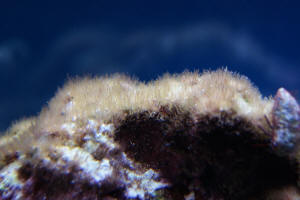 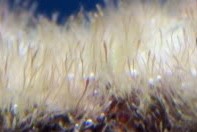 |
|
Predatory Tunicate? More Likely a Sponge
2/5/10
I got a bunch of live rock from my local fish store and when I
got home I noticed a small Grey slimy spot on one of the rocks.
Since then it has grown a lot. When I feed my fish it actually
opens up what I call its mouth (all of them) and takes what falls
on it. I did put a piece of fresh shrimp next to it and watched
but it had no tentacles, but it did have a web like covering over
its mouth when it opened up, when feeding is done it closes up
again. I showed it the person that I got the live rock from, but
he had no idea what it was. If anyone could possibly know what it
is
please get back. Its driving me crazy not knowing what it is.
<I wish the photos were a little more clear, but looks like a
sponge to me.
I don't think it's a tunicate because they are generally
difficult to keep in captivity, a sponge is more likely to
proliferate as you described.>
Thanks
<Welcome,
Mich>
|
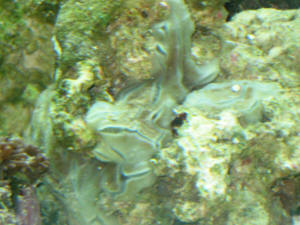 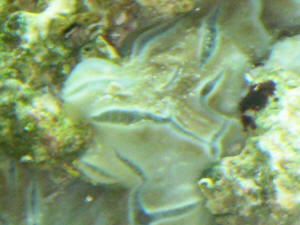 |
|
?coral? -- 02/02/10
Thanks in advance for your time you've helped me in the
past...have another mystery in my tank - grown over 6 month
period. Is this ok? Or is it invasive? Thanks again! :)
<This looks like macro algae to me... maybe Rhodophyte sp....
probably a good thing. Whatever it is, it looks healthy, and
producing a lot of CO2 bubbles. :-)>
(ps: also sent instant message with two pics... But not sure if
you get instant messages )
<we do not>
<Cheers,
Sara M.>
|
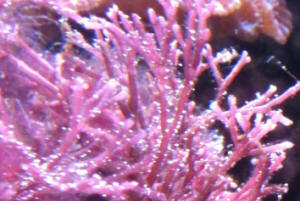 Agreed! RMF Agreed! RMF |
|
Coral Identification 1/8/10
Hi there!
<Hello!>
I was wondering if you could help me identify this coral.
<Mmm, don't think this is a Cnidarian>
I think it might actually be some sort of plant (the turbo snails
love it and have been munching on it a lot).
It's thick and just drapes over the rock. It really is pretty
but I have no idea how to care for it.
<Likely "doing whatever it is you are
doing"...>
It came on the rock with a few other things growing on it and it
is so striking. The LFS keeps getting more in but with no
description--they are baffled too.
Thanks for your help.
Rhonda
<Likely this is either an algae, sponge or Bryozoan... Do you
have a low-power microscope? Perhaps one that is USB enabled that
you can make some pix with? Bob Fenner>
|
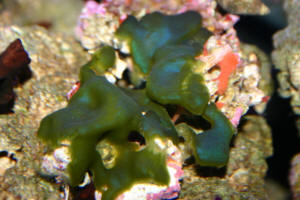 |
Unidentified life form; likely gastropod --
01/05/10
Crew;
<Hi John.>
Sorry to bother you again but I have found a new nocturnal inhabitant
in my tank a few hours ago and have looked on Google and you site and
other images but have no clue what it is. I attempted to get a picture
of it but since it was fairly dark (only moon lamps on and did not want
to scare the tank into awakening so early (3AM) I decided to leave well
enough alone and will describe it to the best of my ability. This is
the first time I have seen this little guy so I have no idea how long
it has actually been a member of my community.
Some brief history:
I found one of my larger Mexican turbo snails grazing near my Zoa
colony and after an hour or so later I noticed the Zoa was knocked off
the rock I had it tied to (obviously not very securely he he). So I did
an emergency re-tying down in the low light condition. When I pick up a
small piece of LR to get the other LR home of the Zoa retrieved and to
retrieve my fishing line I was using to tie down the Zoa I noticed
movement which started me a bit.
After a closer observation I thought what I saw was a snail but there
is not a visible shell. I watched it as it came across the substrate
and onto the glass. It measures 2cm in length (measured it while on the
aquarium glass), has two antennae (or what I deemed to be antennae) one
longer than the other. It had a foot very similar to a snail but again,
after looking closely through a 6x magnifying glass it had no
discernable shell. It was a pale color, almost gray in appearance with
a small hump in the back with what looked like spikes. I then assumed
it may be some type of slug, so I briefly turned on the lights (< 1
minute) to see if any color. The hump was a very very pale yellowish
color (almost white and the body had very small darker spots scattered
about all over except underside of foot). I turned the lights off again
and watched it for about 15 minutes. It went across the entire front of
the aquarium across the side then up near one of the powerheads when I
lost sight of it because it is not well lit there (remember have only
moon lighting on). I suppose it possibly could have been a hitchhiker
as well since the Zoa (was not attached to any rock/frag piece when
purchased) and Green Star Polyps (on a rock frag) (both very small) are
recent additions to the tank (Zoa about 3 weeks and the Star about a
week). I am hesitant to believe this came with the LR as a hitchhiker
due to the curing process and the newest piece of rock has now been in
tank only about 2 weeks now.
I have 2 Turbo Mexican Snails and 2 Nassarius snails in the tank.
Is it possible to have had this life form hitchhike on the LR, make it
through the full curing process and take up residence in my little
piece of the ocean?
<Oh yes. Many life forms are quite hardy and survive the processes
of transport and curing hidden in rock crevices.>
It was pretty quick for its size and I am almost certain it is a type
of snail just growing it's shell possibly?
<No.>
I thought all snails required a shell in which to retreat and live from
birth, either by growing or picking one up along the way.
<No picking up, they are no hermit crabs.>
Is it possible that one of the listed snails I mentioned had a
child?
<No.>
I apologize for asking you to try and ID something with just a
description and will send my picture I took if so requested to further
assist you.
<If you think it might help and contains at least some detail feel
free to send it.>
I do have a pic of it, but it is of the foot and another from an odd
angle to try and get the top portion of the life form but both are not
real
definitive so I do not want to ask you to identify something from a
picture, especially since it is of low quality. John. Marine tank
Newbie, Marine lover always.
<Without a clear picture it is hard to give you a definite ID. A
most common hitchhiker are Stomatella and related snails from the
family Haliotidae. They have small shells that may look like a bump and
long retractable antennae. They are fast for a snail and their flat
shell can have small holes. You may want to compare your hitchhiker to
some online pictures. Other less common hitchhikers are sea hares, they
have bumpy backs, no shell, ear like antennae (more often four). They
come in various colors and shapes. A third possibility is you saw a sea
slug (Nudibranch)'¦ there are more than 3000 species in
various colors and shapes. Cheers, Marco.>
Thanks for the assistance!!
Unidentified life form; likely gastropod II -- 1/6/10
Marco et al;
<Hi John.>
Just a follow-up on my recent question asking about my unidentified
hitchhiker.
Following your possible suggestions, I thoroughly researched each one
you mentioned. I easily ruled out Sea Hares. I looked at a lot of
images, some worse than what I took, lol). Took a few hours but I am
now pretty certain it is a Stomatella.
<Fine. I brought up the Nudibranchs, because you noted possible
spikes on the bump (which would be their breathing organs, but
Stomatella type snails can also have holes/tiny decorations on their
flat shell.>
This makes me a happy camper. I read they will reproduce. I have a few
questions related to them;
Will they consume red hair algae?
<Only if you have masses of Stomatella.>
I have read they are not compatible, necessarily, with wrasses. I have
2 McCosker's Flasher Wrasses. Is this a bad pairing?
<I cannot exclude they'll eat smaller individuals, but I think
this comment mostly applies to snail eating wrasses and/or small snail
species.>
If I have seen one, what are the odds there are more? (am interested in
hopefully reproducing more.)
<Quite good, they often lead a secretive life.>
I must add, you guys are amazing. Being able to at least steer one in
the correct direction, with just enough info, that if one truly does
their research can further their knowledge. You have done exactly that.
You gave a few possibilities, I researched and now am a tad bit more
knowledgeable. I appreciate this gentle guidance more than words can
say.
<Thank you very much for your kind words.>
For someone who is new to the hobby, I do try to use the search engine
as much as possible, but it can be a bit hard when one has no clue what
direction to search... hard to search for something when one has
absolutely no idea where or what they are searching for!
<Kudos to you for your effort. Not every hobbyist would be willing
to spend a few hours on a snail he saw once at night.>
Much appreciated. John. Marine tank Newbie, Marine lover always.
<Cheers, Marco.>
|
Can you identify this? 12/30/09
I have a very odd organism growing in my 6 month old 65 gallon
Red Sea tank. All is well in the tank, I am just mystified as to
whether this is a sponge, algae, or what. The organisms have not
grown greater than 15 mm in
diameter, are loosely attached to rocks, and they appear to wax
and wane in numbers. (I presume a crab or shrimp may be eating
them) As the photo shows, they are translucent with a hairy
coat.
<This coating is BGA:
http://wetwebmedia.com/bluegralgae.htm>
On taking one out of the tank, I found it easily detached from
the rock. An attempt to cut it in half with a razor blade proved
it to be easily squished like a soft sponge. They are only
growing where they get light. I have been keeping marine aquaria
since the 70's, and have never seen something like this. Have
you?
<Can't make out the base material from the pic... could be
a sponge or tunicate, or? I'd work on limiting the
Cyanobacteria, per your reading the linked files above the
referred file. Bob Fenner>
|
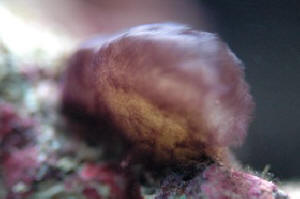 |
|
Re: Can you identify this? LR f'
12/31/09
Dear Mr. Fenner;
<Howdy Seth!>
I did think exactly what you concluded at first, but if it were a
sponge being covered with cyanobacteria, one would expect to a)
see the cyanobacteria on other surfaces in the tank
<Mmm, not necessarily, no>
and b) see the sponge in unlit areas, free of any covering.
<Ditto>
Neither is the case. FYI, my parameters are pH - 8.4, Alk -
approx 2 millieq/l, PO4 - 0 ppm, NH3/NH4+ - 0 ppm, NO2 - 0.01
ppm, NO3 - 0 ppm, I keep the salinity @ 35 ppt, temp. @ 79-80
deg. F. I have the Red Sea Max lights on 9 hours/day, feed
DT's phytoplankton 8 ml/day (less than half their
recommendation). There are 6 species of macroalgae flourishing,
as well as a thriving "Kenya tree" soft coral, a
rapidly growing pulsing Xenia which has now two offspring, a long
polyp toadstool, a Parazoanthus gracilis colony. There are eight
unidentified encrusting polyps as well.
Lots to eat up nitrogenous waste. Other inhabitants are a Tomini
bristletooth tang, 5 small azure damsels, a scooter dragonet,
three Mithrax crabs, several tiny unidentified hitchhiker crabs,
an urchin, one skunk cleaner shrimp, one peppermint shrimp, a
brittle star a serpent star, and two small horseshoe crabs to
sift the sand. Plus of course, myriad filter feeders, such as
clams that came on live rock, three species of sponge, all
growing albeit slowly, Byrozoans, various "feather
duster" worms in the rocks, several snails, and five hermit
crabs.
<Wow! Quite a mix, and from what I can make out from your
attached pic, all looks good>
Having been a volunteer for Dr. Walter Adey when he was still at
the Smithsonian, I do not scrub the water clean of plankton with
100% filtration or a skimmer. This allows me to feed very
sparingly, about 1 ml frozen brine shrimp per week (which mostly
goes to the Parazoanthus colony). and occasional miniscule pieces
of shrimp to the brittle star (mostly to keep it from stealing
from the Parazoanthus!). I regrettably do not have the room or
materials to set up a true algal turf scrubber system, but to me
the main thing is having a balanced ecosystem, which I believe I
have achieved. I am not concerned about these critters (I am
calling them tribbles - that's what they look like, though
they don't seem to have the reproductive speed of tribbles,
which is a good thing...)
They don't bother me; I'm just curious. As I've been
writing, it occurs to me that since many corals have
photosynthetic bacteria in them as symbionts, is it possible this
is the same deal? It would explain not seeing one without the
other....
<Mmm, no... I think you just have "some"
opportunistic BGA here>
Well, thanks for your time, let me know if you have further
thoughts on this. Wishing you an excellent New Year, I am,
respectfully yours,
Seth R. Honig.
<Do take a look/see through a 'scope if you can... the
cell structure of Cyanobacteria is rather definitive. Cheers!
BobF>
|
|
Identification Help 12/17/09
Hello Bob and Crew!
<Greg>
Could you please identify the life form in the attached photo.
They are "sprouting" out of my live rock. The one in
the photo is a smaller one, so mostly the lime green can be seen,
but when larger, they are white with a green tip. I can't
recall any other tank I have seen with these present.
Am I the "lucky" one, or perhaps not so lucky!
Thanks,
Greg
<Mmm, lucky. This is a green algae of the genus Neomeris.
Happy holidays, BobF>
|
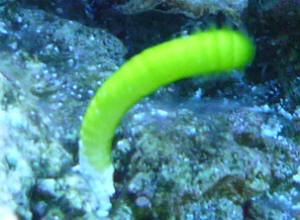 |
Tube with single foot long "hair" extending from
it... No pic 11/30/09
Hi guys! I have searched your site up one side and down the other to
find any info on this new critter in my one year old reef tank. It
appears to inhabit a calcified white tube that is about 2 inches long
and 1/4 inch in diameter. I cannot see any part of the animal but it
extends and retracts a foot long "hair". It just appeared
this week so I am baffled as this tank is about a year old. At first I
thought it was a hair as I have long hair and thought it came from me
while cleaning or feeding. I have removed the "hair" several
times with my tank tongs and it reappears the next day!!
Any thoughts?
Thanks,
Amy
<Is likely a tube snail... but could be a type of tube worm
(Sedentariate Polychaete). Read here:
http://wetwebmedia.com/MolluscPIX/Gastropods/Prosobranch%20PIX/Vermetids/tubesnailidf.htm
and here: http://wetwebmedia.com/featheridfaqs.htm
and the linked files above. Bob Fenner>
|
Identification Please: Rock-Dwelling Cuke --
11/23/09
<Hello, Lynn here this evening.>
I was hoping you could identify this thing for me!!??
<I'll sure try!>
Attached is a picture of it at night feeding. It lives inside of
the rock and feeds just like my sea cucumber.
<For good reason! It's a neat little rock-dwelling Sea
Cucumber/Holothuroid. For more information/photos, please see the
related FAQ's at the following link, especially 'Anemone
Id? Nope, It's A Cuke! 8/10/07':
http://www.wetwebmedia.com/cukeidfaqs.htm
Terrific photos under the FAQ titled 'Hitchhiker ID:
Rock-Dwelling Sea Cucumber -- 6/17/09':
http://www.wetwebmedia.com/cukeidf4.htm >
Hope it is not bad!!!
<You should be okay unless it's a large Cuke in a small
tank. Please see the above links for more information related to
risk. Take care, LynnZ>
|
 |
Red Stuff On My Rock, Nullipora 11/23/09
Hello:
<Hi Paul>
I have had this problem with my tank for about a year or so and this
time I cant seem to solve it.
The tank is a 175G Oceanic bow ,and has various creatures within it and
they are no problem.
My issue is a red hard coating on all my live rock I have tried to
mechanically remove it and it won't come off. I think it piggy
backed on a batch of live rock I bought and it spread and stayed. Its
not coralline algae, I have that still in spots, but its the same
consistency. Its not slime algae I have had that before and used slime
remover and it left, this is different and even though I have taken a
piece of live rock out and tried to scrub it off it will not come off
easily.
I have seen this red stuff being referenced on the net and its been
said that there is nothing that will take it out. I used an urchin and
it eats it but unfortunately it also eats coralline algae and can't
get in tight spots.
I guess my question if you guys have the time would be, have you heard
of something like it and a way of removing it short of scrubbing my
rock clean? I have had this tank for 5 years.
I understand that I probably have omitted a lot of info but I am trying
to keep this letter short in the hopes someone has heard of this stuff
before, and an explanation of all the other stuff I have in the tank
would not take up time which I have a feeling you guys don't have a
lot of.
<The colors of these algae are most typically pink, or some other
shade of red, but some species can be purple, yellow, blue, white or
gray-green.
You likely have a red variety of coralline algae. The urchin eating it
is a good indication of this.>
Thank you in advance.....
<You're welcome. James (Salty Dog)>
Paul Carragozela
|
|

